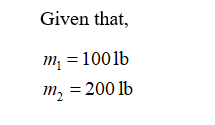Systems (1), (2) and (3) are shown initially at rest. There is no acceleration in the horizontal directions. Determine for each system separately (a) the acceleration of block A (b) the velocity of block A after it has moved through 10 ft (c) the time required for block A to reach a velocity of 20 ft/s
Systems (1), (2) and (3) are shown initially at rest. There is no acceleration in the horizontal directions. Determine for each system separately (a) the acceleration of block A (b) the velocity of block A after it has moved through 10 ft (c) the time required for block A to reach a velocity of 20 ft/s
Related questions
Question

Transcribed Image Text:Systems (1), (2) and (3) are shown initially at rest. There is no acceleration in the
horizontal directions.
Determine for each system separately
(a) the acceleration of block A
(b) the velocity of block A after it has moved through 10 ft
(c) the time required for block A to reach a velocity of 20 ft/s
100 Ib
100 lb
2100 lb
200 Ib
200 Ib
2200 lb
(1)
(2)
(3)
Expert Solution
Step 1

Step by step
Solved in 4 steps with 4 images
